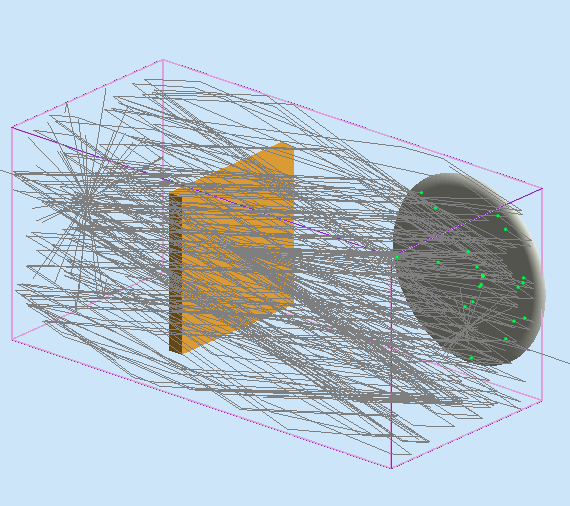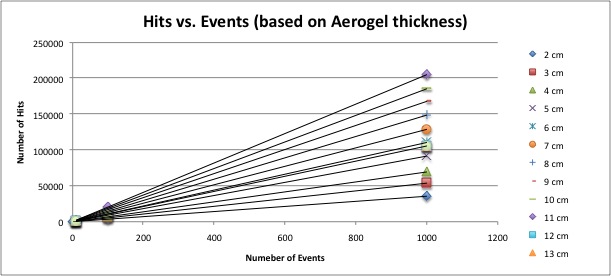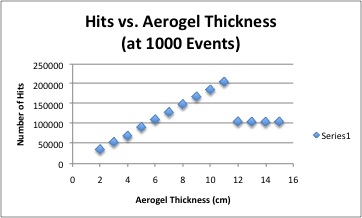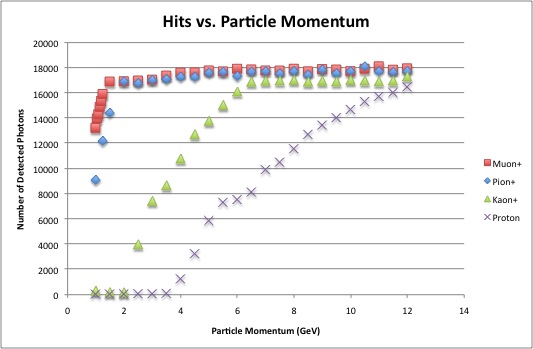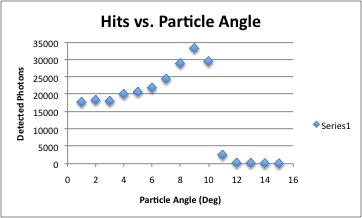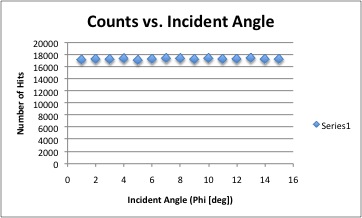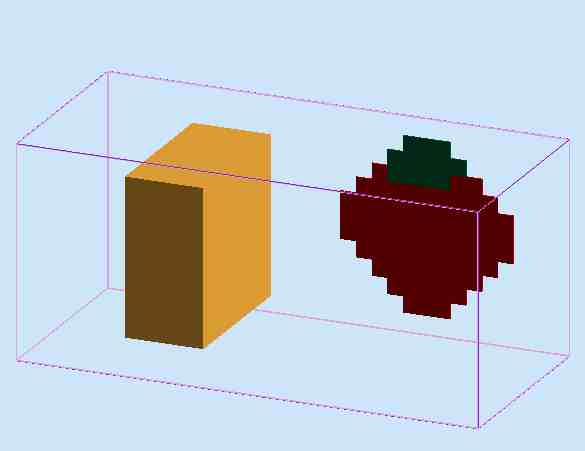MainPage:Nuclear:Summer2012:PrototypeSimulation
| ⇐ Back to Summer 2012 page |
| ⇐ Back to the Main_Page |
This is the page for the simulations Laura is doing in GEMC.
A few notes about the simulation:
- The PMT window is 100% efficient, so all photons that hit the surface are detected as hits. The term "Hit" is synonymous with detected photon.
- The aerogel has a refractive index of 1.03.
- The "MillipMylar" (a material written by Marco to simulate the Mylar lining in the prototype) lining of the box is not diffusely reflective.
- User inputs such as particle type, momentum and position, as well as the number of particle events can be changed in the executable file (exe.s); geometry parameters are changed in the perl script (build_summer.pl). Unless otherwise specified, the aerogel panel is 1cm thick, and the incident particle has a momentum of 3GeV.
Number of Tiles
A number of runs were preformed to study the effect of the number of aerogel tiles (or thickness of a single aerogel tile) has on the efficiency of the detector (ie. how many photons are detected). It can be seen from the plot below (Figure 1) that the relationship is incredibly linear, as would be expected.
Below is a plot of the number of photons detected vs. the thickness of the aerogel (for 1000 events). When the aerogel surpasses a thickness of 11 cm, a good number of the photons emitted are trapped and absorbed within the aerogel instead of escaping to be reflected within the light-box and ultimately detected by the PMT window.
Particle Momentum vs. Number of Detected Photons
Similar to simulations run summer 2011 using the Fortran Monte Carlo program SimCherenkov, I used this GEMC simulation to study the momentum threshold of the incident particle for aerogel of index 1.03. The results seem to be consistent with the behavior seen from the SimCherenkov simulation.
Below is a plot of the number of detected photons vs. the momentum of the incident particle for Kaons, Pion, Muons and Protons over a range of momentum from 1 to 12 GeV.
Position of Incident Particle
Simulations are underway to study the effect of the position of the incident particle on the total number of photons detected. Preliminary results (below, left) show that there is a threshold for the angle "Theta" at which the efficiency drastically diminishes, most likely because the angle at which the particle enters the detector exceeds the path through the aerogel. However, the efficiency of the detector does not depend on the angle "Phi" (below, right), because this angle seems to be the azimuthal angle (the East to West angle as opposed to the North to East angle).
Quantum Efficiency
An option was created for the PMT window in the simulation to be modified to reflect the results of the PMT window scanning tests for Quantum efficiency. There were two steps to this process: 1. The total number of "hits/event" was multiplied by 13% (to account for 40% less than the ideal 22% quantum efficiency). 2. A grid "window pane" was constructed to correspond with the grid pattern used in the PMT scanning. Each pane in this grid acts as a separate PMT window and can be made sensitive or non-sensitive depending on the desired quantum efficiency. Because the area of the grid pattern is already ~15% smaller than the normal round PMT window, a further 12 cm^2 was "turned off" to account for the average 40% of the PMT window that is non-sensitive according to the PMT scanning. To calculate the number of photoelectrons using the grid window, the average hits/event count was multiplied by 22% (the ideal quantum efficiency).
The results from these two methods of calculating the expected number of photoelectrons agree with one another. However, there is still some discrepancy between the number of expected photoelectrons based on simulation results and the number of photoelectrons calculated based on the empirical prototype testing (this is still being investigated).
SimCherenkov
SimCherenkov was a simulation program written by Dr. Higgenbothem of JLab and modified by Nathaniel Hlavin and Laura Rothgeb to simulate both the SHMS detector and the prototype. Below is a link to the 2011 DNP CEU poster presenting the results of the summer 2011 study of the effect of light guides on aerogel Cherenkov detectors.
Documentation
June 27, 2012, Group Meeting Presentation File:27June.pdf
Excel Workbook, Aerogel Thickness File:Prototype simulation aerogel thickness.pdf
Excel Workbook, Particle Angle File:Prototype simulation particle angle.pdf
Excel Workbook, Particle Momentum File:Prototype simulation particle momentum.pdf
